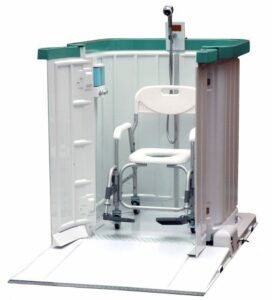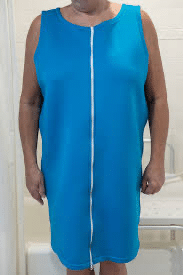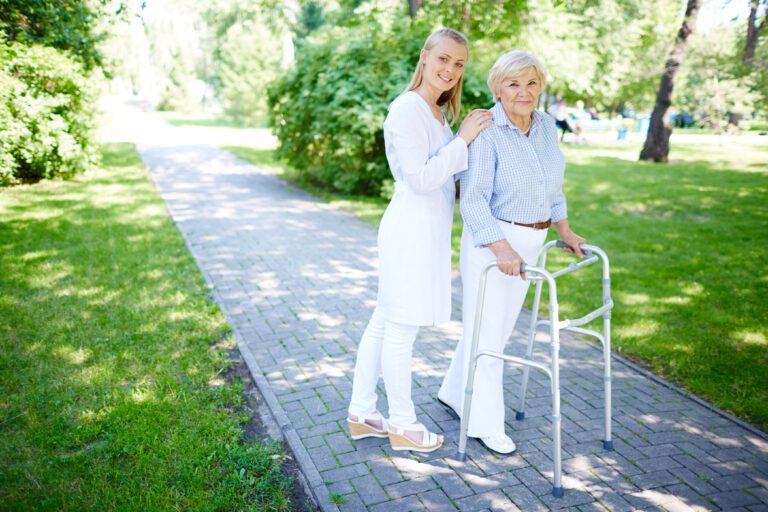Your once meticulously groomed mom, who never missed her daily shower, is now adamantly refusing to bathe. It’s baffling, heartbreaking, and stressful. Many of us have been there. Let’s dive into understanding why this happens and how to make shower time less stressful for everyone involved.
Showering can become a significant challenge for people with dementia. They might fear the water, feel cold, or become stressed. For caregivers, this often turns a simple daily task into a battle of wills. However, with a bit of patience and some creative strategies, you can make the experience more comfortable and dignified for your loved one.
Seniors Do Not Need to Shower Daily
 Seniors don’t necessarily need to shower every day. In fact, showering two to three times a week is often sufficient to maintain good hygiene for elderly individuals, especially those with limited mobility or skin sensitivities.
Seniors don’t necessarily need to shower every day. In fact, showering two to three times a week is often sufficient to maintain good hygiene for elderly individuals, especially those with limited mobility or skin sensitivities.
Over-showering can strip the skin of essential oils, leading to dryness and irritation. On days they don’t shower, caregivers can use alternative methods to ensure cleanliness. No-rinse bathing wipes or sponge baths are excellent options for cleaning the body without the need for a full shower.
Pay particular attention to areas prone to sweat and odor, such as the underarms, groin, and feet. Regularly changing clothes, using deodorant, and moisturizing the skin can also help maintain hygiene and comfort. By adapting the bathing routine to suit their needs, caregivers can ensure that seniors stay clean and comfortable while minimizing stress and the risk of skin issues.
Families Struggle to Understand the Fear and Stress Associated with Showering with Dementia
Many seniors with dementia develop a fear of water. The sound and sensation can be overwhelming, causing significant stress. A study published in the American Journal of Nursing (PDF) highlights that older adults often resist assisted bathing due to factors like confusion, anxiety from being naked in front of others, fear of falling, and discomfort from cold or drafty bathing areas. These feelings are exacerbated by the cognitive impairments associated with dementia, which can make the experience feel threatening and unfamiliar.
One helpful tip is to create a warm, inviting environment. Pre-warm towels in the dryer and make sure the bathroom is toasty. A cozy bathroom can make a world of difference. According to the Alzheimer Society of Canada (PDF), maintaining the person’s privacy and dignity during bathing is crucial. They recommend using warm towels and robes to help the person feel more secure and comfortable.
Additionally, dementia can alter a person’s perception, making water seem more intimidating. The Alzheimer’s Society notes that some people with dementia have trouble with depth perception, which can make a dark bathmat look like a hole. This misperception can contribute to their fear and stress during bath time. Using contrasting colors to help the person distinguish between different objects in the bathroom can mitigate this issue.
Creating a calming atmosphere can also help. Playing soft music and using gentle, soothing scents in the bathroom can create a spa-like environment that helps reduce anxiety. Tepa Snow, a renowned dementia care expert, suggests that the noise of running water and echoes in the bathroom can be particularly distressing. Her webinars and educational materials emphasize the importance of creating a calm, quiet environment to ease the stress of bathing.
In summary, understanding and addressing the sources of fear and stress associated with bathing can transform a daunting task into a more manageable and even pleasant experience for both the caregiver and the person with dementia. By creating a warm, inviting, and calming environment, and using person-centered approaches, you can help reduce the anxiety and discomfort that often accompany bath time.
Tackling the Exhaustion Factor of Showering for a Senior
A common scenario might look like this for trying to get a senior with dementia to shower. Every day, Shannon helps her dad, Frank, with his shower. Frank, once a spry man who could tackle any task, now finds the simple act of bathing utterly exhausting. At 85, Frank has both physical and cognitive limitations that make showering a daunting challenge, even with Shannon’s help.
Frank has arthritis in his knees and shoulders. This makes bending, reaching, and standing for long periods painful and tiring. Just the thought of having to undress, shower, and then get dressed again is enough to sap his energy. For many seniors like Frank, the physical effort required for bathing is overwhelming.
But it’s not just the physical limitations. Dementia complicates things further. Frank often forgets the steps involved in taking a shower. He might not remember to test the water temperature or how to use the soap. Cognitive decline affects his ability to sequence tasks, making the process confusing and exhausting. Shannon often finds herself having to guide him through each step, which can be time-consuming and frustrating for both of them.
Despite Shannon’s assistance, Frank’s cognitive and physical limitations make showering a monumental task. He feels rushed and anxious, which only adds to his fatigue. Shannon notices that by the time Frank is halfway through his shower, he is visibly drained, his energy depleted.
Here are a few strategies Shannon has found helpful in tackling the exhaustion factor:
- Simplify the Process: Shannon uses a shower chair to help Frank conserve his energy. This way, he can sit comfortably while showering, reducing the strain on his knees and back. According to a study published in the American Journal of Nursing, using a shower chair can significantly reduce physical discomfort and fatigue in elderly patients .
- Handheld Showerhead: A handheld showerhead allows Shannon to direct the water where it’s needed without making Frank move too much. This simple tool helps make the process quicker and less tiring for him.
- Breaking Down Tasks: Shannon breaks down the showering process into small, manageable steps. She guides Frank through each step, such as washing his hair or soaping his body, one at a time. This approach helps him focus on one thing at a time and reduces confusion and fatigue. According to the Alzheimer Society of Canada, communicating tasks in short, simple steps can make a big difference in helping people with dementia manage daily activities.
- Routine and Familiarity: Establishing a consistent routine helps Frank know what to expect, which reduces his anxiety and makes the process smoother. Shannon tries to stick to the same shower time each day and uses familiar products that Frank likes, such as his favorite lavender soap. Familiarity can be comforting and make the process less taxing .
- Positive Reinforcement: Shannon encourages Frank throughout the process, offering praise and reassurance. She tells him, “You’re doing great, Dad!” or “Just a little bit more, and we’ll be done.” Positive reinforcement can boost his confidence and make him feel less overwhelmed.
Overcoming the Loss of Interest in Personal Hygiene
It’s common for people with dementia to lose interest in personal hygiene. They may forget why showering is necessary or how to do it. Try to integrate their past routines and favorite products. If mom always used lavender soap, keep that familiar scent in her routine. These little comforts can help rekindle her interest in staying clean.
Addressing the Fear of Falling in the Bathroom
For many seniors, the fear of falling in the shower is not just an abstract worry—it’s a real and pressing concern. For example, Joan is 78, she’s had a couple of falls in the past year, one of which occurred as she was stepping out of the shower. Now, every time she thinks about bathing, anxiety grips her. This fear is common among older adults and can make them resistant to showering altogether.
Statistics paint a clear picture of why this fear is so prevalent. According to the Centers for Disease Control and Prevention (CDC), one out of four of older adults experience a fall each year, and bathroom falls are particularly common. In fact, more than 80% of bathroom injuries among seniors are caused by falls, with a significant number occurring while getting in or out of the shower or tub.
Making the Bathroom Safe
Understanding these statistics underscores the importance of making the bathroom as safe as possible. Here are some practical steps you can take:
- Non-Slip Mats or flooring: Placing non-slip mats inside and outside the shower can provide better footing and reduce the risk of slipping. These mats are an inexpensive and effective way to add safety.
- Grab Bars: Installing grab bars in and around the shower area can give seniors something to hold onto as they move, offering them additional stability.
- Shower Chairs: A sturdy shower chair can make a big difference. It allows seniors to sit while they bathe, which not only conserves energy but also minimizes the risk of slipping or falling. I prefer shower chairs with a high back, swivel seat and one arm.
- Handheld Showerhead: Using a handheld showerhead can help keep the water flow under control and directed where it’s needed, making it easier for seniors to stay seated and avoid unnecessary movements that could lead to falls.
Innovative Solutions: Shower Bay for Safe and Comfortable Bathing
 For caregivers unable to modify their current bathroom setup, I have seen the Shower Bay. It offers an innovative solution that ensures safety and comfort for seniors. This portable shower unit is designed to provide a full shower experience without the need for costly home renovations. Shower Bay can be assembled quickly and easily, connecting to a standard faucet, making it ideal for homes where bathroom modifications are not feasible. The unit features a sturdy shower chair, non-slip surfaces, and grab bars, addressing the critical safety concerns of falls and slips. With its compact design, it can be set up in any room, allowing caregivers to create a safe bathing environment anywhere in the home. This flexibility is particularly beneficial for seniors who may have mobility issues or fear of traditional showers. Shower Bay transforms the bathing process into a safer, more accessible, and stress-free experience, ensuring that seniors can maintain their hygiene with dignity and comfort.
For caregivers unable to modify their current bathroom setup, I have seen the Shower Bay. It offers an innovative solution that ensures safety and comfort for seniors. This portable shower unit is designed to provide a full shower experience without the need for costly home renovations. Shower Bay can be assembled quickly and easily, connecting to a standard faucet, making it ideal for homes where bathroom modifications are not feasible. The unit features a sturdy shower chair, non-slip surfaces, and grab bars, addressing the critical safety concerns of falls and slips. With its compact design, it can be set up in any room, allowing caregivers to create a safe bathing environment anywhere in the home. This flexibility is particularly beneficial for seniors who may have mobility issues or fear of traditional showers. Shower Bay transforms the bathing process into a safer, more accessible, and stress-free experience, ensuring that seniors can maintain their hygiene with dignity and comfort.
Addressing the Anxiety
Making physical modifications to the bathroom is a crucial step, but addressing the psychological aspect of the fear is just as important. Here’s how:
- Reassurance and Support: Be present to provide reassurance and physical support. Letting your loved one know that you’re there to help can significantly ease their anxiety. Always be within arm’s reach during their shower to offer assistance if needed.
- Routine and Familiarity: Establishing a routine can help reduce anxiety. When seniors know what to expect, they are less likely to feel nervous. Stick to a consistent shower schedule and use familiar products that they are comfortable with.
- Step-by-Step Guidance: Clearly explain each step of the process. For instance, say, “I’m going to turn on the water now. You can sit comfortably while I adjust the temperature.” This kind of communication helps keep them informed and involved, reducing feelings of helplessness and fear.
Managing Discomfort and Pain
For many seniors, the act of showering can be physically uncomfortable or even painful. For Jane, an 82-year-old woman with arthritis in her knees and shoulders, every movement during her shower—from reaching up to wash her hair to bending down to rinse her legs—causes her pain. This discomfort can make the idea of bathing seem like an insurmountable task, leading to resistance and distress.
Pain during showering is common among seniors, particularly those with conditions like arthritis, osteoporosis, or other musculoskeletal issues. According to the NIH, around 60% to 80% of seniors regularly experience pain. For those with dementia, the situation is even more complex because they might not be able to communicate their pain effectively, leading sundowning symptoms such as increased agitation and resistance.
Practical Strategies to Reduce Pain
- Warm Water Therapy: Warm water can soothe sore muscles and joints. Before starting the shower, let the water run to reach a comfortable temperature. According to research, water between 105°F to 110°F can help reduce pain without causing discomfort . Margaret’s caregiver always checks the water temperature to ensure it’s just right, creating a more pleasant and less painful experience for her.
- Gradual Movements: Moving slowly and carefully during the shower can prevent sudden jolts of pain. Margaret’s caregiver always warns her before moving or washing a potentially painful area, giving her time to prepare. This approach helps in managing discomfort and reduces anxiety.
- Adaptive Equipment: Tools like long-handled sponges or brushes can help reach difficult areas without much strain. Margaret uses a long-handled brush to wash her legs, reducing the need for bending.
Pain Management Techniques
- Pre-Shower Analgesics: For seniors with chronic pain, taking pain relief medication before the shower can help manage discomfort. Consult with a healthcare provider to determine the best medication and timing. Margaret takes her prescribed pain medication about 30 minutes before her shower, which helps in reducing the pain significantly.
- Hot Packs: Applying hot packs to sore joints before showering can help relax muscles and ease pain. Margaret’s caregiver places a warm towel over her knees before the shower, which helps in reducing stiffness and pain.
- Gentle Massage: A gentle massage during the shower, especially on sore areas, can provide relief and comfort. Margaret enjoys a light massage on her shoulders with her favorite scented lotion, which not only soothes her pain but also adds a touch of relaxation to the experience.
Adapting to Dementia-Specific Issues
 Dementia introduces unique challenges like confusion and fear of water. Communication is key. Speak in short, simple sentences and demonstrate each step. For instance, “I’m going to wash your arm now,” while showing them the washcloth. Maintain their dignity by covering them with a towel and uncovering only the parts being washed. You can also checkout the Blue Hug as an option to keep them covered and feeling warmer. The Blue Hug Shower Garment is a unique ¾ length shower garment made from nylon jersey lined neoprene providing a soft, luxurious, and comfortable bathing experience. With generous arm and neck openings and high-quality 2-way zippers strategically placed, allowing caregivers to bathe the wearer while maintaining personal dignity and warmth..
Dementia introduces unique challenges like confusion and fear of water. Communication is key. Speak in short, simple sentences and demonstrate each step. For instance, “I’m going to wash your arm now,” while showing them the washcloth. Maintain their dignity by covering them with a towel and uncovering only the parts being washed. You can also checkout the Blue Hug as an option to keep them covered and feeling warmer. The Blue Hug Shower Garment is a unique ¾ length shower garment made from nylon jersey lined neoprene providing a soft, luxurious, and comfortable bathing experience. With generous arm and neck openings and high-quality 2-way zippers strategically placed, allowing caregivers to bathe the wearer while maintaining personal dignity and warmth..
Professional Insights and Tools
Research and professional advice emphasize avoiding forced bathing. Instead, focus on making it a pleasant, human interaction. Resources like Bathing Without a Battle or the Dementia Shower Guide course can provide excellent strategies for caregivers.
Remember, each person with dementia is unique. What works for one might not work for another. Stay flexible, be patient, and prioritize their comfort and dignity. By making a few adjustments, you can transform bath time from a stressful event into a soothing experience.

From a young age, Stacey’s link to the senior care industry grew alongside her mother’s work at a nursing home, where she often accompanied her. By her early teens, she secured her first official job at a nursing home, laying the foundation for a profound journey in senior care spanning over four decades. Her roles varied from opening assisted living and memory care residences to working in nursing homes and independent senior living communities. As the former Director of Fun for 300 independent seniors, she expertly organized daily events and trips. Stacey’s unwavering passion, nurtured by her family, and professional dedication as a recreation therapist, reflect her deep commitment to preserving the dignity and well-being of seniors.
Stacey’s senior care expertise has been recognized by the media including U.S. News and World Report and Care.com.
Stacey and her husband Bryan are the owners of the senior in-home care agency A Place At Home – North Austin.




